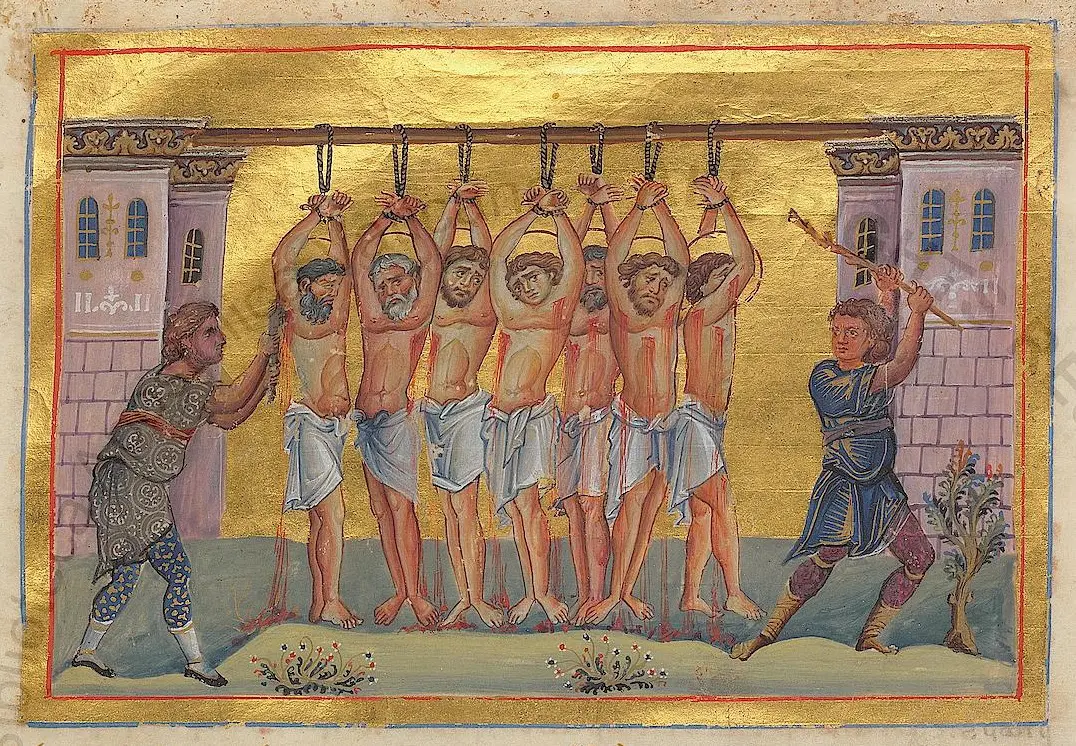
St. Varus was a highly-decorated soldier who lived in Egypt when the Roman emperor Maximian (c. 286 to 305 A.D.) initiated severe persecution against those who refused to worship the pantheon of pagan gods, including Caesar. Christians were singled out for execution because of their refusal to bow down and sacrifice to any god created by human hands.
The story of Varus and his co-sufferers is not only a moving story of tragedy and conviction but also one of hope. Varus’ story, like many stories about the early church martyrs, speaks of the ever-present struggle between the Christian aesthetic of self-sacrificial persuasion and the pagan idea of might-makes-right. This battle, not surprisingly, is still fought in today’s secularized world.
Varus came to know about a group of seven monks who were awaiting execution. These monks would not renounce their faith in Jesus Christ and they would not yield to the ruler of Egypt, for which they endured much suffering. Varus, who was secretly a Christian, was moved by the plight of the monks, and when one of the monks succumbed to torture, Varus gladly offered to take his place and suffer execution.
The servants of the ruler of Egypt were astonished at the sight of Varus among the monks. “What is your business here, Varus?,” they demanded, “Have you lost your mind, giving heed to the myths of which these wicked men tell? Have you no fear that someone will speak of this to the Prince or one of the nobles? You shall lose both your military rank and your life!” Varus replied, “He who tells the Prince of me is my benefactor. Know that if you choose to make an accusation against me, I am ready to die for Christ with the other Christians here.”
Although the servants did not report Varus to the ruler, Varus ultimately volunteered himself for martyrdom alongside the six monks. After five hours of severe torture, Varus’ mutilated corpse was thrown outside the city to be devoured by animals.
At this point, it would seem that evil had won out over good, but the story doesn’t end there. Through the following events, we come to know of the eventual victory of the crucified Savior over the demonic forces of coercion and violence.
There was a Palestinian widow, a mother named Cleopatra who had witnessed Varus’ suffering from afar. Cleopatra brought Varus’ body to her home and buried it there. She regarded Varus as her intercessor and mediator before God. Her motives for doing this remain unknown, but it could be because Cleopatra’s husband had also been an officer of high rank who died in Egypt.
As is typical with most of the lives of saints, tragedy struck Cleopatra; her son died and Cleopatra mourned bitterly. When her son burned with fever, Cleopatra refused to eat and prayed fervently, but she could not save him. “O servant of God!” she lamented to her mediator, “Is this how thou hast rewarded me for the great labors I endured on thy behalf?” Cleopatra wept without consolation at Varus’ grave and fell asleep from weariness. What is recorded as happening next was remarkable, to say the least.
“As she slept, she beheld Saint Varus in a dream. He held her son by the hand, and they both shone like the sun. Their vesture was whiter than snow, and they were girded with golden belts; upon their heads were crowns of unspeakable beauty. Seeing this, the blessed Cleopatra fell down before them, but Saint Varus lifted her up and said, “O woman, why do you cry unto me? Do you imagine that I have forgotten the good works you did on my behalf in Egypt and along the way to this place? Do you suppose that I felt nothing when you removed my body from amid the carcasses of beasts, placing it in a coffin? Have I not always hearkened to your prayers? I make entreaty for you at all times unto God. I have prayed first of all for your relatives, with whom you buried me, that their sins be remitted them, and now I have enrolled your son in the army of the King of Heaven. Did you not beseech me here at my grave that I ask God to grant you and your son whatever is in accordance with His will and is to your benefit? Therefore, I have prayed unto the good God, and in His ineffable kindness He has deigned to number your son among the host of Heaven. Lo, you see that your son now stands near the Lord’s throne.” (Taken from the Slavonic Menologion of St. Demetrius of Rostov)
The story of Varus and Cleopatra is a window to the larger, world-changing event at Calgary where Jesus died at the hands of a frenzied mob. The self-sacrificing stories of the martyrs and Christ serve as both a deconstruction of the notion of might-makes-right and salvation through non-violent interaction. Whereas the rulers of this world and the system they espouse perpetuate human-sacrifice as a means to salvation, Christ and his followers bring salvation through renunciation of coercion, through self-sacrifice.
This method of self-sacrifice — loving the neighbor, as Jesus called it — is not something which we can regulate through empirical means. Rather, it is an aesthetic: something that is transmitted through imitation of Jesus and his followers, whether it be through storytelling, art, music or personal example. It is something that doesn’t come from following the decrees of politicians, but rather from the Holy Spirit working through each one of us.
Today, we are faced with the Christian aesthetic of the martyr at every turn. The self-sacrificial way of Christ has so penetrated our everyday culture that we cannot ignore it any longer. This is why we can recognize injustice even if it approved by the legislative branch of the state. When innocent victims of state legislation, like the powerless parents Jeff Younger and Craig Cesal, like Varus are thrown down for sacrifice on the altar, we recognize injustice for what it is: human sacrifice.
Christ’s crucifixion on the cross shows us the way by which we must affect change; it shows us how we can supplant satan’s influence from all aspects of human governance and bring back God’s monarchy of reconciliation and rehabilitation. “Your kingdom come, your will be done, on earth as it is in heaven,” we pray in the Lord’s prayer. This prayer can be realized when we, like Varus, refuse to bow down to pagan idols — idols that embolden the act of sacrificing others in order to maintain equilibrium. After all, an idol that promises to remove evil through evil is a false idol.
The story of Varus and Cleopatra wonderfully illustrates how we can bask in the loving grace of God’s salvation through compassionate interaction with our neighbor and through communication with the Creator. Prayer is something that is taken for granted as a mere spiritual reality. What we often miss is that prayer is also an anthropological reality, delivering results that penetrate both time and space. Prayer, communication, and interaction are by which we can link God’s mercy with our fallen world.
Let us pray then to renounce coercion and embrace God’s mercy so that all the prisoners be set free from injustice and death.

Articles posted on LCI represent a broad range of views from authors who identify as both Christian and libertarian. Of course, not everyone will agree with every article, and not every article represents an official position from LCI. Please direct any inquiries regarding the specifics of the article to the author.
Did you read this in a non-English version? We would be grateful for your feedback on our auto-translation software.
), //libertarianchristians.com/wp-content/plugins/smartquizbuilder/includes/images/template6-latest.jpeg))

), https://libertarianchristians.com/wp-content/plugins/smartquizbuilder/includes/images/template6-latest.jpeg))








































), https://libertarianchristians.com/wp-content/plugins/smartquizbuilder/includes/images/template6-latest.jpeg))
), https://libertarianchristians.com/wp-content/plugins/smartquizbuilder/includes/images/template6-latest.jpeg))
), https://libertarianchristians.com/wp-content/plugins/smartquizbuilder/includes/images/template6-latest.jpeg))





*by signing up, you also agree to get weekly updates to our newsletter
Sign up and receive updates any day we publish a new article or podcast episode!